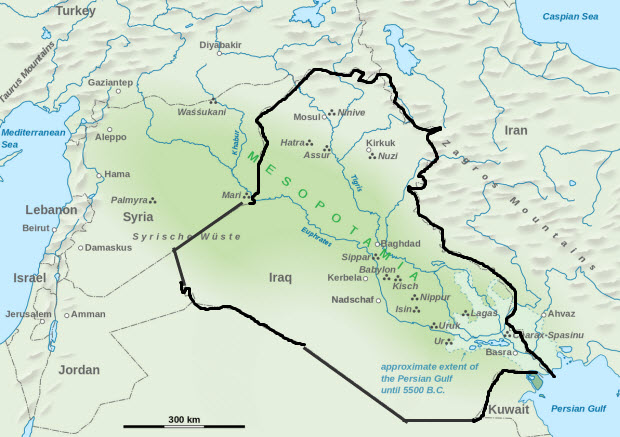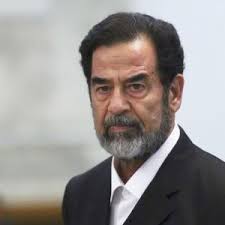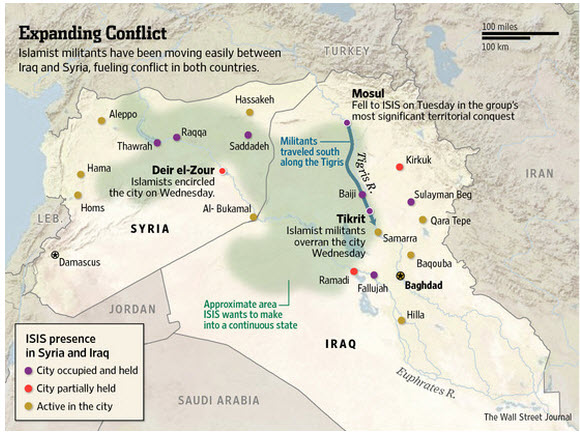By Tyler Durden
इस लेख को पढ़ कर एक बात साफ़ है ही इराक मैं अपने पिता की हार का बदला लेना अमरीका को बहुत महँगा पड गया और अब सारे विश्व को इसकी कीमत चुकानी पड़ेगी .सद्दाम ने इराक को एक कड़े शासन मैं बंधा हुआ था . पश्चिम की प्रजातंत्र की जिद उन संस्कृतियों पर नहीं लागू होती जिन पर पश्चिम अ असर नहीं है .
अब कैसे विश्व इस समस्या से निकलेगा पता नहीं . इस्लामी माप डंडों से सद्दाम एक धर्म निर्पेक्ष शासक ही माने जायेंगे जिन्होंने कश्मीर पर भारत का सदा साथ दिया .ईरान इस युद्ध मैं घुस कर बहुत बड़ी गलती कर रहा है . अंततः यह आग सबको जलाएगी .
 The situation in Iraq is serious, and is probably going to get worse before it gets better. The potential for this recent action to morph into a regional conflict is very high. That that means that oil could go a lot higher, and if it does, we can expect the odds of a global economic recession and an attendant financial crisis to go up considerably from here.
The situation in Iraq is serious, and is probably going to get worse before it gets better. The potential for this recent action to morph into a regional conflict is very high. That that means that oil could go a lot higher, and if it does, we can expect the odds of a global economic recession and an attendant financial crisis to go up considerably from here.Before we dive into what’s actually happening over there right now, I need to begin with a longer and deeper historical context of the region, which is essential to understanding pretty much everything in the Middle East. The western press likes to report on things as if they suddenly occur for no discernible reason, context-free and unconnected to our actions and activities over there. But the story of the Middle East is a story of intense external meddling — especially by the US, recently.
Further, I happen to hold the view that when an entire population resorts to violence, it’s a sign that they feel they have no other options or opportunities. Whether it’s a financially-strapped fired US employee lashing out at their former bosses and co-workers, or an Arab youth raised in utter poverty deciding that military extremism makes sense, I see the same dynamic at play.
People, like animals, when cornered will take whatever path remains for them to escape. If left with no other paths besides violence, then violence is what you get. It’s not really all that hard to understand, and yet the US media goes out of its way to try and frame violent unrest as some form of inexplicable evil that magically appears for no good reason.
Well, there are plenty of reasons why violence exists in the Middle East is violent (and has for a very long time). And most of those have to do with resources, and their exceptionally scarcity in a desert environment.
Of course, the Middle East isn’t unique in this. For instance, the early European Viking raids and endless wars between the European kings during the middle ages were all essentially resource wars. To understand the reasons for war — both ancient and modern — you need to start with resources.
So whenever I hear terms like ‘radical militants’ or ‘Jihadists’ or even ‘terrorists’, what I hear instead is ‘people with poor resources who believe they have no other options.’ The unpleasant truth that threatens the dominant western narrative is that all humans, if they have access to sufficient resources and opportunities, are generally peaceful. By the time an entire population has been ‘radicalized’, the causal problems have been simmering for a long time and, as a result, will not be easily remedied.
Iraq Is Not Really A State
To start this story, we have to go back to the period just after WW I when Britain and France were divvying up the spoils of the region between themselves.
Iraq did not exist prior to these two western powers taking out a map of the Middle east, a ruler and a pen, and summarily drawing straight lines that happened to rather inconsiderately cut across cultural, language and racial boundaries. The architects of this secret agreement were a Brit by the name of Sykes and a Frenchman by the name of Picot.
Prior to this Franco-British interference, the area was called Mesopotamia and had long been ruled by a contentious but roughly-balanced mixture of tribes and kings.
Here’s the old Mesopotamia in green as compared to the borders drawn by Sykes & Picot:

(Source)
To understand the current conflict, you have to understand the history of the borders, how they were drawn, and the extent of western plundering and meddling — which began long before the Bush Iraq wars (I & II) began.
The old partition of the Middle East is dead. I dread to think what will followJune 13, 2014The entire Middle East has been haunted by the Sykes-Picot agreement, which also allowed Britain to implement Foreign Secretary Arthur Balfour’s 1917 promise to give British support to the creation of a Jewish “homeland” in Palestine.The collapsing Ottoman Empire of 1918 was to be split into two on a north-east, south-west axis which would run roughly from near Kirkuk – today under Kurdish control – across from Mosul in northern Iraq and the Syrian desert and through what is now the West Bank to Gaza.Mosul was initially given to the French – its oil surrendered by the British in return for what would become a French buffer zone between Britain and the Russian Caucasus, Baghdad and Basra being safe in British hands below the French lines.But growing British commercial desires for oil took over from imperial agreements. Mosul was configured into the British zone inside the new state of Iraq (previously Mesopotamia), its oil supplies safely in the hands of London.(Source)
It bears mentioning that the area the French and British allotted to themselves was already fully-populated by the people who lived there. However the area was already determined to be rich in oil and other commodities, and both colonial powers were well-practiced at the art of dividing and conquering local people in order to take their resources.
For the people of Mesopotamia, western resource plundering has only accelerated since the arbitrary lines that comprise the ‘state’ of Iraq were drawn.
Of course, it’s quite likely that Iraq’s border were specifically drawn to cut across ethnic boundaries and thereby assure a failed state, because Britain had learned through history that failed states were the easiest to control. This was their preferred MO in India and numerous other colonies, and by 1916 it was a more or less perfected tool of statecraft.
But whether it was ineptitude or malign intent, the fact remains that Iraq was never a logical geographical entity; and its natural state would be to split into three autonomous regions: Kurds to the north, Sunnis to the west and Shiites to the south.
As a quick reminder, the differences between Sunni and Shiite Muslims stems from a split made shortly after the prophet Muhammad died in 632:
Sunni and Shia Islam are the two major denominations of Islam. The demographic breakdown between the two denominations is difficult to assess and varies by source, but a good approximation is that approximately 87-89% of the world’s Muslims are Sunni and approximately 11-12% are Shia, with most Shias belonging to the Twelver tradition and the rest divided between several other groups.Sunnis are a majority in most Muslim communities: in Southeast Asia, China, South Asia, Africa, and most of the Arab world. Shia make up the majority of the citizen population in Iran, Iraq and Bahrain, as well as being a politically significant minority in Lebanon. Azerbaijan is predominantly Shia, however practicing adherents are much lower. Pakistan has the largest Sunni and second-largest Shia Muslim (Twelver) population in the world.Sunnis believe that Abu Bakr, the father of Muhammad’s wife Aisha, was Muhammad’s rightful successor and that the method of choosing or electing leaders (Shura) endorsed by the Quran is the consensus of the Ummah (the Muslim community).Shias believe that Muhammad divinely ordained his cousin and son-in-law Ali (the father of his grandsons Hasan ibn Ali and Hussein ibn Ali) in accordance with the command of God to be the next caliph, making Ali and his direct descendants Muhammad’s successors. Ali was married to Fatimah, Muhammad’s daughter from his wife Khadijah bint Khuwaylid.
The reason it’s important to know the differences between the two main forms of Islam involved is because the balance of power is split across the Middle East is based on which form dominates a given area.
Saudi Arabia is almost entirely Sunni and has been supporting the rebels in Syria and, by extension, in the rebels now in Iraq as well. Iran, on the other hand, is Shiite, as is most of Baghdad and southern Iraq.
The awkward part of this story is that if the US does get involved to help Baghdad out militarily, it would mean fighting on the same side as Iran (and against the forces the Saudi Arabia supports):
Iran sends troops into Iraq to aid fight against Isis militantsJune 14, 2014Iran has sent 2,000 advance troops to Iraq in the past 48 hours to help tackle a jihadist insurgency, a senior Iraqi official has told the Guardian.The confirmation comes as the Iranian president, Hassan Rouhani, said Iran was ready to support Iraq from the mortal threat fast spreading through the country, while the Iraqi prime minister, Nouri al-Maliki, called on citizens to take up arms in their country’s defence.Addressing the country on Saturday, Maliki said rebels from the Islamic State of Iraq and the Levant (Isis) had given “an incentive to the army and to Iraqis to act bravely”. His call to arms came after reports surfaced that hundreds of young men were flocking to volunteer centres across Baghdad to join the fight against Isis.In Iran, Rouhani raised the prospect of Teheran cooperating with its old enemy Washington to defeat the Sunni insurgent group – which is attempting to ignite a sectarian war beyond Iraq’s borders.(Source)
No wonder Washington is hemming and hawing! There’s no way for Obama to send support to Baghdad without undercutting a lot of carefully laid anti-Iranian propaganda. What, we’re going to be fighting on the same side now as our longtime “Death to America!” adversary? Politically this is a real pickle.
But such an unnatural alliance may be happening:
US sends aircraft carrier to Persian Gulf as Obama considers air strikes in IraqJune 14, 2014The US is sending an aircraft carrier and two guided missile ships into the Persian Gulf, bolstering sea and airpower before a possible US strike on the jihadist army in Iraq in the coming days.Defense secretary Chuck Hagel ordered the USS George HW Bush into the Gulf on Saturday, a day after President Barack Obama indicated he would soon decide on air strikes against the Islamic State of Iraq and the Levant (Isis), whose seizure of Sunni Iraqi cities has violently upended the region.(Source)
A bit ironic to be sending the USS George Bush, but there you have it. Once again, the US is poised to deliver more military solutions to what are, at heart, political problems.
As I’ve posted before, I think that sending your biggest ships into the the Persian Gulf bathtub is an outdated tactic that will not last long if/when modern anti-ship missiles are brought into that theater, such as the very impressive Yakhont-800 supersonic anti-ship cruise missile:
The truly awkward part for US foreign policy here is that Iran could likely come out of this with even more influence over Baghdad — possibly even enjoying a permanent ‘protector’ role until or unless some other entity wants to step up to the plate and commit to the job.
Mission Accomplished? That’s going to go down as one of the most premature declarations of all time. More like Missing Accomplishment, if you ask me.
A Lightning-Fast Advance
The situation in Iraq developed fast and continues to move quickly.
Allegedly, nobody saw the rebels from the Islamic State of Iraq and the Levant (Isis) coming. “There was no warning”.
I find that doubtful given all the tools of State right now, but whether warnings were ignored or not, ISIS has moved incredibly fast seizing one city after another as they’ve spread southards:
Islamist Insurgents Advance Toward BaghdadJun 11, 2014Islamist militants swept out of northern Iraq Wednesday to seize their second city in two days, threatening Baghdad and pushing the country’s besieged government to signal it would allow U.S. airstrikes to beat back the advance.An alarmed Iraqi government also asked the U.S. to accelerate delivery of pledged military support, particularly Apache helicopters, F-16 fighters and surveillance equipment, to help push back fighters from the Islamic State of Iraq and al-Sham, an al Qaeda offshoot known as ISIS. The U.S. said it has been expediting shipments of military hardware to the Iraqis all year.Iraqi Foreign Minister Hoshyar Zebari said his country faces a “mortal threat” from the ISIS insurgents.Officials declined to say whether the U.S. would consider conducting airstrikes with drones or manned aircraft. The Obama administration is considering a number of options, according to a senior U.S. official who added that no decisions have been made.Bernadette Meehan, a White House National Security Council spokeswoman, said the current focus of discussions with Iraq “is to build the capacity of the Iraqis to successfully confront and deal with the threat posed by [ISIS].”ISIS overran Tikrit, the birthplace of former dictator Saddam Hussein, on Wednesday after capturing Iraq’s second-largest city, Mosul, a day earlier. The takeover of the city of 250,000 about 85 miles north of Baghdad was confirmed by Ali Al Hamdani, a senior official in Salah Al Din province, where the city is located. The insurgents freed hundreds of prisoners from the city’s jails.By Wednesday evening, there were reports of fighting between Iraqi security forces and Islamists on the outskirts of Samarra, a city further south and less than 80 miles north of the capital.(Source)Regional officials said they were worried that significant stocks of weapons ISIS fighters stole from military bases in northern Iraq could be transported across borders and used in conflicts and terror attacks elsewhere.U.S. counterterrorism officials said on Tuesday that the attacks show the degree to which Islamist militants have established a revolving door between Iraq and Syria, with fighters flowing easily between the two countries and fueling conflict in both.(Source)
Somehow, ISIS rebels numbering in the hundreds, or perhaps low thousands, have managed to rout two full Iraqi brigades numbering some 30,000 troops from their positions and send them fleeing. That tells you everything you need to know about the esprit de corps of the Iraqi ‘army.’ It’s not an effective fighting force at the moment.
Awkward Alliances
Now we get to the second awkward part of this story for the US. Along with Saudi Arabia, the US has been supplying weapons and training to the Syrian rebels many of whom are now heading south towards Baghdad.
To fight them would essentially mean fighting our own weapons and training.
I’m really impressed with the ability of the US news industry, such as in the article above, in keeping out the extremely obvious connection between the hard line Syrian rebels we are supporting and the ISIS rebels now heading south.
After all, it’s not like the news is hidden, or only located on the fringe of the blogosphere. It’s been widely reported for over a year that the US has been providing high level training and weapons to the Syrian rebels. Note that this next article from the Washington Post is over 9 months old:
CIA begins weapons delivery to Syrian rebelsSept 11, 2013The CIA has begun delivering weapons to rebels in Syria, ending months of delay in lethal aid that had been promised by the Obama administration, according to U.S. officials and Syrian figures. The shipments began streaming into the country over the past two weeks, along with separate deliveries by the State Department of vehicles and other gear — a flow of material that marks a major escalation of the U.S. role in Syria’s civil war.(Source)
Even more recently, it’s been reported that the US has provided high tech anti-tank and anti aircraft weapons systems and training. This is state-of-the-art warcraft for ground troops:
U.S. training Syrian rebels; White House ‘stepped up assistance’June 12, 2014WASHINGTON — White House officials refused to comment Friday on a Los Angeles Times report that CIA operatives and U.S. special operations troops have been secretly training Syrian rebels with anti-tank and anti-aircraft weapons since late last year, saying only that the U.S. had increased its assistance to the rebellion.The covert U.S. training at bases in Jordan and Turkey began months before President Obama approved plans to begin directly arming the opposition to Syrian President Bashar Assad, according to U.S. officials and rebel commanders.“We have stepped up our assistance, but I cannot inventory for you all the elements of that assistance,” White House Press Secretary Jay Carney said. “We have provided and will continue to provide substantial assistance to the Syrian opposition, as well as the Supreme Military Council.”(Source)
And PBS recently weighed in with a documentary on the matter, describing training in Qatar which disturbingly sounds a lot like instruction in how to commit war crimes:
Syrian Rebels Describe U.S.-Backed Training in QatarMay 26, 2014WASHINGTON — With reports indicating that forces loyal to Syrian President Bashar Assad are gaining ground in that country’s brutal civil war, moderate Syrian rebels have told a visiting journalist that the United States is arranging their training in Qatar.In a documentary to be aired Tuesday night, the rebels describe their clandestine journey from the Syrian battlefield to meet with their American handlers in Turkey and then travel on to Qatar, where they say they received training in the use of sophisticated weapons and fighting techniques, including, one rebel said, “how to finish off soldiers still alive after an ambush.”The interviews are the latest evidence that after more than three years of warfare, the United States has stepped up the provision of lethal aid to the rebels. In recent months, at least five rebel units have posted videos showing their members firing U.S.-made TOW anti-tank missiles at Syrian positions.The weapons are believed to have come from Saudi Arabia, but experts on international arms transfers have told McClatchy that they could not have been given to the rebels without the approval of the Obama administration.(Source)
At Risk: MUCH Higher Oil Prices
The summary here is that the ‘rebels’ the US is supporting in Syria are part of the very same group that is now headed towards Baghdad. They are all Sunni hard liners and they will not rest until they have created a new Sunni state for themselves.
It’s really that simple.
What’s not simple is understanding what the US’ motivations are here in wanting to topple so many regimes in the Middle East and North Africa. Is it to appease our Saudi allies who also support Sunni causes across the region? Is it to create an entire region of failed states because that serves some larger master plan?
Most importantly, did the US really think that we could both arm the Sunni rebels and support the brutal Shiite hard liner al-Maliki (the current president of Iraq) in Baghdad as he consolidated Shiite power at the expense of the Sunnis? Why arm and support both sides, unless the goal was a bloody and protracted stalemate?
At any rate, US foreign policy is again in tatters and if it seems like there’s no solid plan here, perhaps that’s because there isn’t one. It’s either a really complex and genius plan or intense bumbling and stumbling. Sometimes it’s hard to tell these things apart.
There was practically no chance of Iraq holding together after the US destroyed the country and then left it without any functioning state apparatus strong enough to withstand 14 centuries’ worth of carefully-nurtured resentments in a harsh land with little going for it beyond the oil that will someday be gone.
At any rate, we’ll just have to keep watching as all this develops. In the meantime, the biggest risk here is that this becomes a wider regional war. One that begins by enveloping all of Iraq and which cuts off that countries oil exports for a while.
In Part 2: Oil At Risk, we lay out the very real and growing risk that a coming decrease in Iraq oil exports created by the current turmoil will result in an oil price spike that could approach $150 per barrel (or even worse under certain situations). Such a development would almost certainly plunge the global economy back in to Recession and financial crisis. We address the defensive steps concerned individuals should take now in advance of such a highly undesirable turn of events.
__._,_.___
Show message history
.


